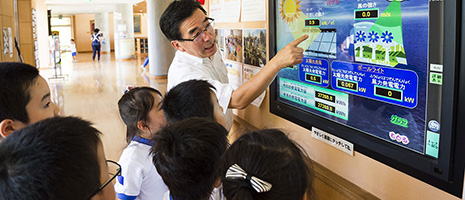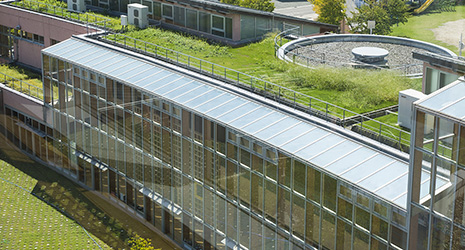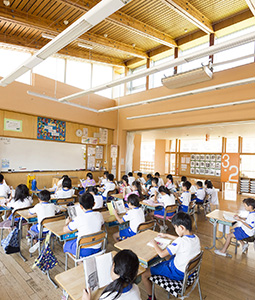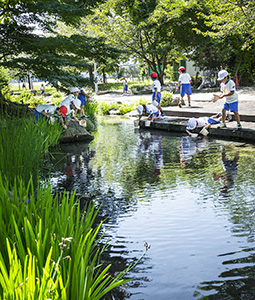Home > Highlighting JAPAN > Highlighting Japan September 2016 > Japan’s Fight Against Global Warming
Highlighting JAPAN


Conservation Education
Oshihara Elementary School in Yamanashi Prefecture uses its eco-friendly amenities to provide its pupils with a high-quality environmental education.
As global warming increasingly poses a global problem, the Japanese Ministry of Education, Culture, Sports, Science and Technology is taking the lead in extending the Eco-School program to schools around the country. Characterized by ecological considerations, Eco-Schools are equipped with various facilities such as solar power generation and energy-saving systems.
Up until 2015, nearly 1,600 kindergartens, elementary schools, junior high schools and high schools had been registered as Eco-Schools. Among these, the municipal Oshihara Elementary School in Showa-cho, Yamanashi Prefecture has particularly extensive eco-friendly equipment.
Having opened in 1884, the rebuilt school buildings of Oshihara Elementary School were completed as an Eco-School in 2004 in accordance with the policy of Showa-cho, namely coexistence between town development and the environment.
Oshihara Elementary School is located almost at the center of the Kofu Basin, surrounded on all four sides by mountains. The elementary school experiences the climate typical of a basin, with very hot summers and very cold winters. To minimize its dependence on a cooling and heating system, Oshihara Elementary School has introduced many different pieces of equipment. For example, the school takes external air into the building through a tube buried underground, known as an earth tube. The underground temperature is lower than the outside air temperature in summer, and higher in winter. Accordingly, it serves as a natural form of air-conditioner. The elementary school’s radiation cooling system circulates groundwater through the pipe to cool the air. The school is also equipped with a night-purge ventilation system, which takes in cool air on hot summer nights through an opening at the top of the building.
The school also has a wooden terrace and eaves outside its classrooms to block direct sunlight and reflections. It also prevents temperature rises by greening its roof and terrace, covering the building with a so-called green curtain and sprinkling groundwater and rainwater from a tank onto the roofs of the school building and gymnasium.
“Here, you don’t need to turn on the air-conditioner a lot to remain comfortable, even in summer,” says Mitsuru Ohta, principal of Oshihara Elementary School. “You would need a very large amount of electric power to obtain the same level of comfort otherwise.”
Oshihara Elementary School has devised many methods of saving energy in addition to the energy-saving equipment for cooling and heating. For example, the top of each classroom is equipped with windows to block direct sunlight and take in natural light. This is referred to as high side light. During the daytime on sunny days, the classroom is sufficiently lit, even when the electric lights are off. The school also stores rainwater in a tank and uses it to flush the toilets and water the plants.
Groundwater is used for a biotope that extends about 150 meters from the front entrance and along the school building. The biotope is full of green waterweed and provides a habitat for killifish, crayfish and other organisms. It also exposes schoolchildren to nature.
Oshihara Elementary School uses these facilities to teach its pupils about the environment. For example, its curriculum on water resources for fourth-year students involves the use of well water and rainwater on the school premises. Science classes for sixth-year students utilize wind and solar power generation to teach about electricity. The first floor of the school building is equipped with a touch-panel LCD monitor that enables a variety of information to be displayed, including the amount of electric power generated by the solar and wind power systems on the premises, the level of consumption of well water and rainwater, and the effects of rooftop greening.
“The school building itself is the material for teaching about the environment,” says Ohta. “Pupils learn that they are in a wonderful school that is friendly to the environment. Naturally, this helps nurture a mindset for avoiding energy waste and placing importance on the natural environment.”
© 2009 Cabinet Office, Government of Japan








